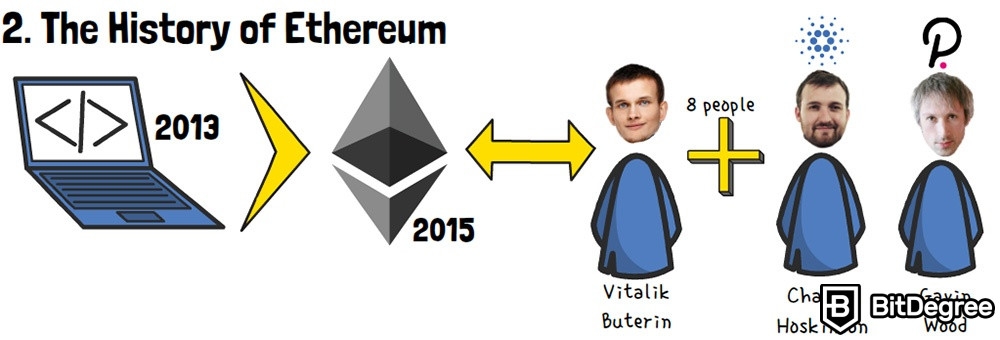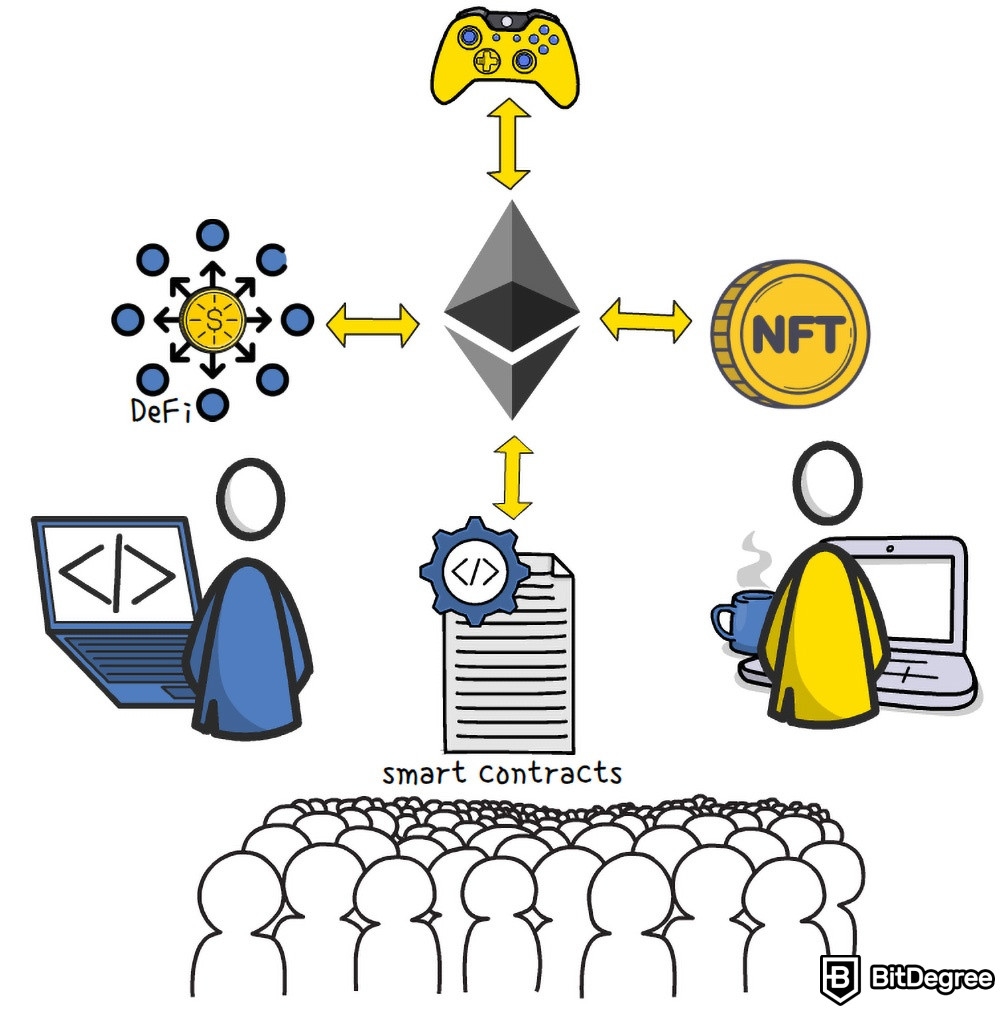2.7 The Ultimate Blockchain for dApp Creation: Ethereum
Stop overpaying - start transferring money with Ogvio. Sign up, invite friends & grab Rewards now! 🎁
In this section, we’re going to answer the questions what is Ethereum, and how does it work?
What visuals come to your mind when you hear the term “global computer”? Some people will probably imagine a sentient being, overseeing all of the different processes that we perform, every day. Or maybe you’re thinking about something along the lines of the Terminator - a dangerous machine that’s out to destroy humanity?
Well, while everyone is going to have their own thoughts concerning the matter, “global computer” is actually a term that is often used to describe a very well-known cryptocurrency project called Ethereum.
In this section, we are going to talk about Ethereum. To be a bit more specific, we’ll look into what is Ethereum, in simple terms, the history of this project (how it came to be), what makes it so special, and we’ll also ponder on what does the future of ETH look like, as well.
So, let’s get to it!

Video Explainer
Video Explainer: The Ultimate Blockchain for dApp Creation: Ethereum
Reading is not your thing? Watch the "The Ultimate Blockchain for dApp Creation: Ethereum" video explainer
What is Ethereum & What is it Used For? (Animated Explanation)


What is Ethereum?
Let’s start off with the core question - what is Ethereum?
Now, as I’ve hinted in the beginning, the term “global computer” is actually quite accurate, when describing ETH. In technical terms, Ethereum is a public blockchain software that allows users to create different middleman-less projects on it, with the help of smart contracts and a native coin called Ether.

That’s a lot to unpack, I admit - let me give you an example.
Imagine that you want to sell your car. You have a few choices, none of which are looking ideal to you - you could sell it yourself, but that would involve having to likely talk to a lot of different people, and spend your time and energy showing the car. You could skip this, and hire a car-selling service, but they would then take a huge cut from your sale.
To add to all of that, after the sale is done, there’s also a ton of paperwork to go through and sort out - once again, it looks like a really big headache!
As you think about your options, you come across an interesting service online - a special platform that allows you to sell your car without any middlemen, or any additional bureaucratic processes to go through. Once the sale is done, the platform takes a small commission, and all of your paperwork gets sorted out automatically, as well. The entire process is 100% automated and provably fair!
Theoretically, that is very possible, with the help of Ethereum and smart contracts. If you’d like to learn more about the latter, there is a dedicated section on our Crypto 101 Handbook, explaining all of the different intricacies of smart contract functionality. For now, suffice to say that smart contracts were first introduced on Ethereum, and that they act as a middleman between two parties participating in some sort of a process (such as selling a car).
The kicker here, though, is that smart contracts are automated, decentralized, and immutable. In theory, they make everything much faster and simpler, too!
Thanks to smart contracts and some arduous development work, Ethereum has become the second-largest cryptocurrency project on the market, right after Bitcoin. This is a massive deal, and has put a pretty big spotlight on ETH, and the technology behind it! In fact, smart contract functionality is where the definition “global computer” originated from, as well. On top of that, it’s also part of the answer to the question “what is the difference between Bitcoin and Ethereum?” - smart contracts!
While I only gave you a single example of how the technology behind Ethereum can be used in the real world, the possibilities are endless! ETH can theoretically help automate a huge assortment of actions and services, all the while making them much fairer and faster, too. A lot of developers know this, and thus choose to build their own crypto-native projects on the Ethereum blockchain.
More on that a bit later, though - in order to talk about this side of Ethereum, we need to first look into the history of this cryptocurrency project.
The History of Ethereum
Ethereum first saw the light of day in 2015. Up until that point, though, the technology behind this blockchain project had already been in development for a couple of years.

Whenever we think about Ethereum today, we usually associate it with a man named Vitalik Buterin. He was *one* of the co-founders of ETH, but as you might have guessed, not the only one. In fact, in total, Ethereum was founded by 8 people, including the likes of Charles Hoskinson (the founder of Cardano) and Gavin Wood (the creator of Polkadot).
Why, then, is Vitalik the only one who people associate with Ethereum, nowadays? Well, it’s a whole big story, in of itself. However, long story short, out of those 8 initial founders, Vitalk is currently the only one left, working on ETH.
Throughout the years, Ethereum had a variety of ups and downs, and has experienced a lot of different updates in the process. While the blockchain was always a bit controversial (mostly due to its problems with scalability and network fees), the biggest controversy that it has experienced, to date, is likely a hack that happened all the way back in 2016. It was a DAO hack during which a huge amount of Ether was stolen, and that divided the Ethereum community into two.

Like, literally - Ethereum experienced a hard fork, which resulted in two separate blockchain projects. Ethereum that we know today (this is the updated version of the original blockchain, with the security vulnerability fixed), and Ethereum Classic, the original ETH project, but with multiple security vulnerabilities still supposedly present. So, when someone asks “what is Ethereum Classic?”, or “what is the difference between Ethereum and Ethereum Classic?”, you’ll now know!
Now, I’ve also just mentioned a number of different terms - DAOs, hard forks, and so on. If you’re not familiar with any of these terms, or are wondering - what is Ethereum gas, or address types, please feel free to check out other chapters in our Crypto 101 Handbook - there's a variety of dedicated sections explaining difficult cryptocurrency topics, as simply as possible!
The history of Ethereum deserves a section of its own, and I won’t bore you with all of the specific details that made ETH what it is today - instead, we’re going to focus on figuring out what is Ethereum used for, and how it works.
My point here is that, while ETH experienced a lot of bumps in the road, as of writing this section, it’s still one of the most popular cryptocurrency projects in the industry, and one that has paved the way for decentralized finance (or, DeFi) and a huge variety of technological blockchain advancements.
In order to get Ethereum explained fully, you do also need to know what is Wrapped Ethereum. There's a dedicated section about wrapped coins, in general, but if you come across wETH, and don’t understand what that is, just keep in mind that it simply is Ethereum based on a different network, such as the Binance Chain.
What Makes Ethereum Special?
Continuing on with this “What is Ethereum?” section, it's actually a good place to transition to what makes ETH special, and how it managed to become the second-largest crypto project in the world.
As I’ve mentioned earlier, many developers, to this day, choose to build their projects on Ethereum. The fact that they are able to do so, in the first place, is one of the big reasons behind the popularity of this blockchain.

You can think of Ethereum as an actual computer! If you want to play a game, write an essay, or create a slideshow presentation, you can do so on a huge variety of different computers out there - however, if you have the chance to use a time-tested, reliable machine, you would probably go for it, right? While the computer might not support some super-fancy applications, and has some occasional lag, with it, you’d be able to access most games and apps on the market - it’s a huge factor to consider!
The same is true with Ethereum. If you’re creating a decentralized application (a dApp - say, a crypto game), you probably want to do so on a reliable blockchain, and one that houses as many potential players as possible. In both cases, Ethereum comes out on top!
With most dApps and various crypto projects still being built on ETH, this incentivizes new developers to do the same (since there’s a booming ecosystem on the said blockchain). From the user perspective, things aren’t much different - if you use an Ethereum dApp, chances are that it will have a large community following, which might not be the case for the same dApp built on a different blockchain.
So… How does this make Ethereum special? Well, to put it in layman’s terms, over time, Ethereum has essentially managed to build a huge following, and a dedicated group of users. This is true both in regards to developers, as well as end-users, who interact with the projects present on this blockchain.
Initially, Ethereum attracted people due to its groundbreaking smart contract functionality. As more and more people started using the network, this resulted in a snowball effect - with DeFi, NFTs, and crypto gaming surging in popularity, more people are starting to interact with these areas, and with most of the projects being based on Ethereum, this results in the growth of this particular network, as well.
Wrapping Up: The Future of Ethereum
In this “Ethereum explained” section, we’ve talked about what is Ethereum used for, and what makes this piece of crypto technology so special. At this point, you should be pretty well-versed in all-things-ETH, both when it comes to the history of the network, as well as the hype surrounding it, as well.
What does the future of Ethereum look like, though? After all, as time goes on, there are new, more modern and improved networks coming around - ones that seemingly offer many more perks than ETH!
Well, truth be told, there have been countless “Ethereum killers” over the years - yet, the blockchain still stands tall as one of the most popular crypto projects of all time. Yes, it’s true that ETH isn’t without its issues and controversies - lack of scalability, huge network gas fees, outdated functionalities, and so on. However, as of writing this section, the Ethereum Merge has just recently happened.

While it will take some time to see the true effects of ETH 2.0, if you’re wondering “what is Ethereum 2.0?”, just know that this is the biggest update to the Ethereum network, as of yet, and it aims to solve (or at least mitigate) many of the issues associated with this blockchain, one of which is the transition from Proof-of-Work to Proof-of-Stake (so, people would now be able to stake Ethereum). If you’d like to learn more about what all of that means, or the ETH 2.0 update, make sure to go through the whole Crypto 101 Handbook - it features sections covering many of these topics!










